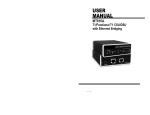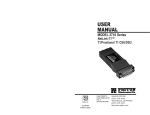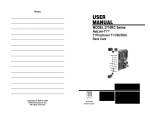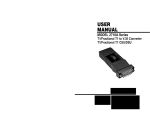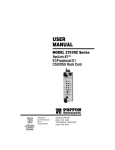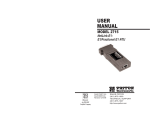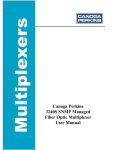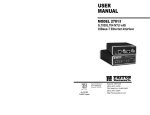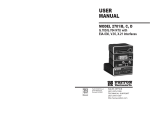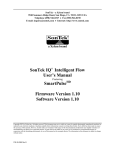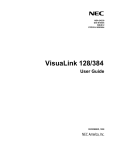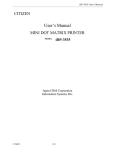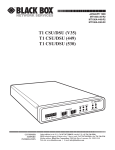Download Patton electronic NetLink 2720 User's Manual
Transcript
USER MANUAL MODEL 2720/I T1/Fractional T1 CSU/DSU with Ethernet Bridging Part# 07M2720/I-A Doc#086181UA Revised 04/11/01 CERTIFIED An ISO-9001 Certified Company SALES OFFICE (301) 975-1000 TECHNICAL SUPPORT (301) 975-1007 http://www.patton.com TABLE OF CONTENTS Section Page 1.0 Warranty Information .............................................................2 1.1 Warranty Statement 1.2 Radio and TV Interference 1.3 Equipment Attachment Limitations 1.4 FCC Compliance 1.5 Service Information 2.0 General Information...............................................................4 2.1 Features 2.2 General Product Description 3.0 Configuration .........................................................................5 3.1 DIP Switch Configuration 3.2 Software Configuration 4.0 Installation ..........................................................................32 4.1 The Model 1001R14 Rack Chassis 4.2 Installing the Interface Driver Board 4.3 Installing the 2720 Into the Rack Chassis 4.4 Connecting to a DTE Device 4.5 Connecting to a DCE Device 4.6 Connecting the T1 Interface 5.0 Operation .............................................................................36 5.1 LED Descriptions 5.2 Loop (V.54 & Telco) Diagnostics 5.3 Bit Error Rate (V.52) Diagnostics Appendix Appendix Appendix Appendix Appendix A - Specifications ........................................................41 B - Cable Recommendations......................................42 C - Factory Replacement Parts and Accessories ......43 D - T1 Interface Pin Assignments ..............................44 E - DTE Interface Pin Assignments............................45 1 1.0 WARRANTY INFORMATION Thank you for your purchase of this Patton Electronics product. This product has been thoroughly inspected and tested and is warranted for One Year parts and labor. If any questions or problems arise during installation or use of this product, please do not hesitate to contact Patton Electronics Technical Support at (301) 975-1007. 1.1 WARRANTY STATEMENT Patton Electronics warrants all Model 2720 Series components to be free from defects, and will—at our option—repair or replace the product should it fail within one year from the first date of shipment. This warranty is limited to defects in workmanship or materials, and does not cover customer damage, abuse, or unauthorized modification. This product contains no serviceable parts; therefore you should not attempt to modify the unit in any way. If this product fails or does not perform as warranted, your sole recourse shall be repair or replacement as described above. Under no condition shall Patton Electronics be liable for any damages incurred by the use of this product. These damages include, but are not limited to, the following: lost profits, lost savings and incidental or consequential damages arising from the use of or inability to use this product. Patton Electronics specifically disclaims all other warranties, expressed or implied, and the installation or use of this product shall be deemed an acceptance of these terms. In the event that you detect intermittent or continuous product malfunction due to nearby high power transmitting radio frequency equipment, use only data cables with an external outer shield bonded to a metal or metalized connector. WARNING! This device is not intended to be connected to the public telephone network in Europe. 1.2 RADIO AND TV INTERFERENCE The NetLink-T1™ Model 2720 Series generates and uses radio frequency energy, and if not installed and used properly—that is, in strict accordance with the manufacturer's instructions—may cause interference to radio and television reception. The Model 2720 Series has been tested and found to comply with the limits for a Class A computing device in accordance with the specifications in Subpart J of Part 15 of FCC rules, which are designed to provide reasonable protection from such interference in a commercial installation. However, there is no guarantee that interference will not occur in a particular installation. If the Model 2720 Series causes interference to radio or television reception, which can be determined by disconnecting the cables, try to correct the interference by one or more of the following measures: moving the computing equipment away from the receiver, re-orienting the receiving antenna, and/or plugging the receiving equipment into a different AC outlet (such that the computing equipment and receiver are on different branches). 2 1.3 INDUSTRY CANADA NOTICE The Canadian Department of Communications label identifies certified equipment. This certification means that the equipment meets certain telecommunications network protective, operational and safety requirements. The Department does not guarantee the equipment will operate to the user's satisfaction. Before installing this equipment, users should ensure that it is permissible to be connected to the facilities of the local telecommunications company. The equipment must also be installed using an acceptable method of connection. In some cases, the company’s inside wiring associated with a single line individual service may be extended by means of a certified connector assembly (telephone extension cord). The customer should be aware that compliance with the above condition may not prevent degradation of service in some situations. Repairs to some certified equipment should be made by an authorized maintenance facility designated by the supplier. Any repairs or alterations made by the user to this equipment, or equipment malfunctions, may give the telecommunications company cause to request the user to disconnect the equipment. Users should ensure for their own protection that the ground connections of the power utility, telephone lines and internal metallic water pipe system, are connected together. This protection may be particularly important in rural areas. CAUTION: Users should not attempt to make such connections themselves, but should contact the appropriate electric inspection authority, or electrician, as appropriate. 1.4 FCC INFORMATION leased line facilities. The Universal Service Order Code (USOC) is RJ48. The Facility Interface Codes (FIC) are 04DU9-BN, 04DU9-DN, 04DU9-1KN, and 04DU9-1SN. The Service Order Code (SOC) is 6.0N. Service 1.544 Mbps 1.544 Mbps 1.544 Mbps 1.544 Mbps SF format without line power SF and B8ZS without line power ANSI ESF without line power ANSI ESF and B8ZS w/o line power Service Code 6.0N 6.0N 6.0N 6.0N Network Connection RJ48C RJ48C RJ48C RJ48C 1.5 FCC PART 68 COMPLIANCE STATEMENT This equipment complies with Part 68 of FCC Rules. Please note the following: 1. You are required to request serivce from the telephone company before you connnect the CSU to a network. When you request serivce, you must provide the telephone company with the following data. When you request T1 Service, you must provide the telephone company with the Facility Interface Code. Provide the telephone company with both of the following codes: 04DU9-B (1.544 MB D4 framing format) and 04DU9-C (1.544 MB ESF format). The telephone company will select the code it has available. The Service Order Code(s) (SOC): 6.0N. The required Universal Service Order Code (USOC) jack: RJ 48C. The make, model number, and FCC Registration number of the CSU. 2. Your telephone company may make changes to its facilities, equipment, operations, or procedures that could affect the proper functioning of your equipment. The telephone company will notify you in advance of such changes to give you and opportunity to maintain uninterrupted telephone service. The Model 2720 Series has been tested and registered in compliance with the specifications in Part 68 of the FCC rules. A label on the equipment bears the FCC registration number. You may be requested to provide this information to your telephone company. Your telephone company may make changes in its facilities, equipment, operations or procedures that could affect the proper operation of the Model 2720 Series. If this happens, the telephone company should give you advance notice to prevent the interruption of your service. The telephone company may decide to temporarily discontinue your service if they believe your Model 2720 Series may cause harm to the telephone network. Whenever possible, they will contact you in advance. If you elect to do so, you have the right to file a complaint with the FCC. If you have any trouble operating the Model 2720 Series, please contact Patton Electronics Technical Support 301-975-1000. The telephone company may ask you to disconnect the equipment from the telephone network until the problem has been corrected or until you are certain that the Model 2720 Series is not malfunctioning. In accordance with FCC rules and regulation CFR 47 68.218(b)(6), you must notify the telephone company prior to disconnection. The following information may be required when applying to your local telephone company for 3 Facility Interface Code 04DU9-BN 04DU9-DN 04DU9-1KN 04DU9-1SN 4 3. If your CSU causes harm to the telephone network, the telephone company may temporarily discontinue your service. If possible, they will notify you in advance, but if advance notice is not practical, you will be notified as soon as possible and will be informed of your right to file a complaint with the FCC. 4. If you experience trouble with the CSU, please contact Patton Electronics, Co. for service or repairs. Repairs should be performed only by Patton Electronics Co. 5. You are required to notify the telephone company when you disconnect the CSU from the network. 1.6 SERVICE INFORMATION All warranty and non-warranty repairs must be returned freight prepaid and insured to Patton Electronics. All returns must have a Return Materials Authorization number on the outside of the shipping container. This number may be obtained from Patton Electronics Technical Support at: tel: (301) 975-1007 email: [email protected] www: http://www.patton.com. NOTE: Packages received without an RMA number will not be accepted. Patton Electronics' technical staff is also available to answer any questions that might arise concerning the installation or use of your Patton Model 2720. Technical Support hours: 8AM to 5PM EST, Monday through Friday. 1.7 CE NOTICE The CE symbol on your Patton Electronics equipment indicates that it is in compliance with the Electromagnetic Compatibility (EMC) directive and the Low Voltage Directive (LVD) of the European Union (EU). A Certificate of Compliance is available by contacting Technical Support. 2.0 GENERAL INFORMATION Thank you for your purchase of this Patton Electronics product. This product has been thoroughly inspected and tested and is warranted for One Year parts and labor. If any questions arise during installation or use of the unit, contact Patton Electronics Technical Services at (301) 975-1007. 2.1 FEATURES • Terminates T1/FT1 Circuits over a 4-Wire RJ-48C interface • 10Base-T Ethernet bridge • PPP (Point to Point Protocol, RFC 1661) with Bridge Control Protocol (RFC 1638) • Unstructured Rates at 1.544 Mbps • D4 or ESF Framing Modes • Supports AMI or B8ZS/B7ZS Line Coding • Configuration via Software Control Port or Internal DIP Switches • Six Easy-to-Read LED Indicators Monitor Data & Diagnostics • Internal or Receive Recover Clocking • Also Operates as a High-Speed Point-to-Point Modem • Made in USA 2.2 GENERAL PRODUCT DESCRIPTION The NetLink-T1™ Model 2720/I is a single port T1/FT1 CSU/DSU with Ethernet Bridging that provides high-speed LAN-to-WAN connectivity. Plugging directly into the 10Base-T port of a hub or LAN switch, the NetLink-T1™ provides T1 or FT1 access at connection data rates of 1.544 Mbps, nx64, and nx56 (n=1 to 24 channels). The NetlinkT1™ is an excellent choice for internet access as well as LAN-to-LAN services. The Netlink-T1™ provides digital access to a local WAN service provider or directly between two facilities over a dedicated 4-Wire circuit. WAN bandwidth, framing and coding options are programmed via externally accessible DIP switches or via a VT-100 type terminal using the rear-mounted EIA-232 Control Port. Netlink-T1™ supports D4/ESF framing options and AMI/B8ZS/B7ZS line coding. Netlink-T1™ also supports a full range of system and diagnostic features that make system setup easy. The Ethernet Bridge in this unit requires no configuration at all. The NetLink-T1™ provides T1 terminations over a modular RJ-48C jack and comply with jitter tolerance capabilities as specified in ANSI T1.403 and AT&T TR62411. External power options include 120VAC and universal interface 100-240VAC. 48VDC and rack card versions are also available. 5 6 3.0 PPP Operational Background PPP is a protocol used for multi-plexed transport over a pointto-point link. PPP operates on all full duplex media, and is a symmetric peer-to-peer protocol, which can be broken into three main components: 1. A standard method to encapsulate datagrams over serial links; 2. A Link Control Protocol (LCP) to establish, configure, and test the data-link connection; 3. A family of Network Control Protocols (NCPs) to establish and configure different network layer protocols. In order to establish communications over a point-to-point link, each end of the PPP link must first announce its capabilities and agree on the parameters of the link’s operation. This exchange is facilitated through LCP Configure-Request packets. Once the link has been established and optional facilities have been negotiated, PPP will attempt to establish a network protocol. PPP will use Network Control Protocol (NCP) to choose and configure one or more network layer protocols. Once each of the network layer protocols have been configured, datagrams from the established network layer protocol can be sent over the link. The link will remain configured for these communications until explicit LCP or NCP packets close the link down, or until some external event occurs. The PPP Bridging Control Protocol (BCP), defined in RFC 1638, configures and enables/disables the bridge protocol on both ends of the point-to-point link. BCP uses the same packet exchange mechanism as the Link Control Protocol (LCP). BCP is a Network Control Protocol of PPP, bridge packets may not be exchanged until PPP has reached the network layer protocol phase. 3.1 APPLICATIONS Patton 2720 Bridge Router Ethernet LAN PEC Device w/ Serial I/F Figure 1. Cisco router with serial interface, configured as PPP Half Bridge. For example, the customer site is assigned the addresses 192.168.1.0/24 through 192.168.1.1/24. The address 192.168.1.1/24 is also the default gateway for the remote network. The above settings remove any routing/forwarding intelligence from the CPE. The associated Cisco configuration will set serial interface (s0) to accommodate half bridging for the above example. Authentication is optional under PPP. In a point-to-point leased-line link, incoming customer facilities are usually fixed in nature, therefore authentication is generally not required. If the foreign device requires authentication via PAP or CHAP, the PPP software will respond with default Peer-ID consisting of the units Ethernet MAC address and a password which consists of the unit’s Ethernet MAC address. Some networking systems do not define network numbers in packets sent out over a network. If a packet does not have a specific destination network number, a router will assume that the packet is set up for the local segment and will not forward it to any other sub-network. However, in cases where two devices need to communicate over the wide-area, bridging can be used to transport non-routable protocols. Figure 2 illustrates transparent bridging between two routers over a serial interface (s0). Bridging will occur between the two Ethernet Interfaces on Router A (e0 and e1) and the two Ethernet Interfaces on Router B (e0 and e1). 2720/I In situations where a routed network requires connectivity to a remote Ethernet network, the interface on a router can be configured as a PPP IP Half Bridge. The serial line to the remote bridge functions as a Virtual Ethernet interface, effectively extending the routers serial port connection to the remote network. The bridge device sends bridge packets (BPDU's) to the router's serial interface. The router will receive the layer three address information and will forward these packets based on its IP address. Figure 1 shows a typical Cisco router with a serial interface configured as a PPP Half Bridge. The router serial interface uses a remote device that supports PPP bridging to function as a node on the remote Ethernet network. The serial interface on the Cisco will have an IP address on the same Ethernet subnet as the bridge. 7 ! no ip routing ! interface Ethernet0 ip address 1.1.1.1 255.255.255.0 bridge-group 1 ! interface Serial0 ip address 1.1.1.1 255.255.255.0 encapsulation PPP bridge-group 1 ! interface Serial1 ip address 2.2.2.2 255.255.255.0 bridge-group 1 ! bridge 1 protocol ieee ! Serial Interface T1/FT1 Link Router A S0 S1 Router B e0 Using Bridge-Groups, multiple remote LANs can be bridged over the wide-area. LAN LAN S1 S0 e0 LAN LAN e1 LAN 2720/I Serial Interface T1/FT1 Link Figure 2. Transparent bridging between two routers over a serial interface. 8 3.1.1 Switch S2 Line Framing Options: The table below shows the default configurations for Switch S2. A description of all S2 options follows this table. S2 SUMMARY TABLE Position Function Factory Default Selected Option S2-1 Data Rate On S2-2 Data Rate On S2-3 Data Rate On S2-4 Framing & Coding Off ESF/B8ZS S2-5 DS0 Rate On 64 kbps S2-6 Clock Mode Off Network S2-7 Clock Mode Off Network S2-8 Reserved Off Reserved 1.536 Mbps (DTE Rate) Switches S2-1, S2-2, and S2-3 Use Switches S2-1, S2-2 and S2-3 to set the DTE data rate. Each setting represents an nx56/nx64 setting. Individual channel settings can be configured through the software control port. S2-1 Off On Off On Off On Off On S2-2 Off Off On On Off Off On On S2-3 Off Off Off Off On On On On Speed Clear Channel (Unframed) 112kbps/128kbps 224kbps/256kbps 336kbps/384kbps 448kbps/512kbps 672kbps/768kbps 896kbps/1024kbps 1344kbps/1536kbps D4/Superframe: The D4 framing format, as specified in AT&T TR62411 is the standard in which twelve frames make up a superframe. All signaling and synchronization are done inband. Extended Superframe (ESF): Extended Superframe, as specified in AT&T TR 54016, consists of twenty-four (24) T1 frames. The framing bits are now used for framing, CRC and the Facility Data Link (FDL). The FDL allows maintenance messages and information to be passed between the 2720 and the Central Office. Line Coding Options: Alternate Mark Inversion (AMI): This mode does not inherently account for ones density. To meet this requirement, each time slot can be reduced to 56 kbps and the Least Significant Bit (LSB) of each time slot set to one. Bipolar 8 Zero Substitution (B8ZS): This mode assures proper bit density in the data stream. In this mode any data pattern can be transmitted without causing ones density errors. This mode allows for 64 kbps clear channel timeslots. Switch S2-5: DS0 Channel Rate Use Switch S2-5 to set the DS0 rate. SW2-5 Off On Setting 56 kbps 64 kbps Switch S2-4: Line Framing and Coding Use Switch S2-4 to control the Network Line Framing and Coding Options. Set these options to be the same as the Line Framing and Coding Options given to you by your Service Provider. If you are using two Model 2720s together as short range modems, set both units identically. S2-4 Off On Line Framing & Coding ESF/B8ZS D4/AMI 9 10 Switch S2-6 and S2-7: Clock Mode Set Switch S2-6 and S2-7 to determine the 2720’s transmitter timing. S2-6 Off On S2-7 Off Off Clock Mode Network Clock. Transmitter timing is derived from the received line signal. Internal Clock. Transmitter clock is derived from an internal oscillator. NOTE 1: When using the Model 2720 as a high-speed short range modem, one unit of the link must be configured in Internal Clock mode, and the opposite end unit must be configured for Network Clock mode. If the ERR LED on the front of the unit is flashing (or on) it could be an indication of a clocking problem. Double check your clock mode settings and Tx Clock Invert S1-3 settings. 3.1.2 Switch S1 The chart below shows the default configurations for Switch S1. A description of all S1 options follows this table. S1 SUMMARY TABE Position Function Factory Default S1-1 RDL Type On S1-2 Reserved On S1-3 Tx Clock Invert Off S1-4 Line Build Out Off S1-5 Selected Option V.54 RDL Normal 0dB Off S1-6 Reserved Off S1-7 S1-8 Reserved Reserved Off Off Switch S1-1: RDL Type Switch S2-8 Reserved Switch S1-1 selects the type of Remote Digital Loopback that the 2720 will initiate when the RDL is initiated from this unit. The 2720 will respond to both the V54 and the CSU loopback regardless of the setting of S1-1 S1-1 On Off RDL Type Initiate a V.54 RDL loop when selected Initiate a CSU loopback when selected Switch S1-2: Reserved 11 12 Switch S1-3: Tx Clock Invert 3.2 SOFTWARE CONFIGURATION Switch S1-3 allows the user to invert the transmit clock originating in the 2720. When S1-2 is set for transmit clock, it may be necessary to invert the transmit clock to allow for delays due to long cables. The Model 2720 features a menu-driven command system that allows you to monitor/configure its operating parameters. Follow the instructions below to configure the Model 2720 using the software selections: S1-3 On Off Tx Clock Invert Transmit clock is inverted Transmit clock is normal 1) Switches S1-4 and S1-5: Line Build Out Use Switches S1-4 and S1-5 to set the Line Build Out (LBO). The Line Build Out varies the pulse shape and attenuation of the signal sent to the network. The amount of Line Build Out depends on NetLink™ T1’s distance to the last repeater. The telephone company providing the service will advise on the amount of LBO necessary. In most cases the default setting will suffice. SW1-4 Off On Off On SW1-5 Off Off On On Function (0dB) -7.5dB -15.0dB -22.5dB Switch S1-6 Through S1-8: Reserved Plug the 9-pin male end of the cable to your terminal or computer’s DB-9 serial port and start up the terminal emulator software if necessary. Plug the miniature stereo plug into the rear of the unit. The small recessed jack on the left side of the unit is the control port jack. NOTE: If your terminal uses a DB-25 connector, please use a DB-9 to DB-25 Adapter to connect to the cable. 2) Power up the terminal and set its RS-232 port as follows: 9600 Baud 8 data bits, 1 stop bit, no parity Local echo off ANSI or VT-100 emulation 3) Here is an example of a terminal emulator setup session. In normal font are the various parameter types. In bold type are the values that should be used for best results. Your terminal program’s setup screen may differ from this one: Baud rate: 9600 Parity: None Data Length: 8 Default terminal type: Local Echo: Add Line Feeds after CRs: Received Backspace Destructive: Backspace key sends: XON/XOFF software flow control: CTS/RTS hardware flow control: DSR/DTR hardware flow control: 13 VT100 Off Off On BS On Off Off 14 Stop Bits: 1 4) When the unit is first turned on, the terminal screen may appear blank. Press the [Enter] key. If your serial connection is good, the unit will immediately display a password prompt. The following message will appear in the middle of the screen: 3.2.1 Introduction to Main Menu After entering the password, you may access all of the system’s functions and parameters. The Main Menu looks like this: Patton Electronics Menu Management Enter Password: _ 5) Type in the password and press [Enter]. The factory default password for the unit is (password is case sensitive): patton HELPFUL HINTS NOTE: If the entry is incorrect, the password screen will clear and prompt you again for the correct password. The password you enter will not be shown. For security, asterisks will be displayed for each letter you type. The maximum length of the password, which can include any character the terminal can generate, is 16 characters. 6) 1. To make a selection, key the highlighted letter that corresponds to a menu selection. 2. To execute the selection, type [Enter/CR] 3. To toggle between options on a highlighted selection, Press [space]. 4. Select d Save Changes from Main Menu after making modifications to any Model 2720 parameter. Otherwise, changes will be lost when the Model 2720 is turned off. The Model 2720 will then display the Main Menu screen. 15 16 The Main Menu options are briefly described below. a System Configuration options allow you to change various aspects of the Model 2720’s operation, e.g., framing, line coding, and aggregate bandwidth. b System Diagnostics/Statistics options allow you to monitor the network performance, initiate V.54 loops, local loops, and send test patterns. Network performance parameters are updated once a second, giving you the ability to quickly determine if there is a problem. c Unit Options allow you to customize the Model 2720 for your location. You can change the default header names to give each unit a unique name and password. Also, you can reset the unit to its default settings without the manual. It also has a Service Information screen in case you need technical assistance from Patton Electronics. d Save Changes. Once you have configured the unit to your satisfaction, you can save the changes permanently by executing the Save Changes command. This will update the unit’s configuration and save all the parameters to permanent memory. e Logoff. For security, log off the control menu by executing the Logoff command. This will blank the screen until an [Enter] key is pressed. 3.2.2 System Configuration The default System Configuration menu looks like this: The System Configuration options are described below: a Line Format: ESF (default) Options: ESF, D4, UNFRAMED D4: This is an older, but widely used, line format that does not provide FDL, so network interface performance cannot be monitored so easily. AT&T TR 62411 contains the specifications for this format and the ESF. D4 is also known as Superframe format. According to TR 62411, “The Superframe format…consists of 12 frames of 193 bits each for a total of 2316 bits. Each 193 bit frame consists of 192 bits preceded by one framing bit….the framing bit is time shared to both synchronize the terminal equipment and to identify the signaling frames.” (Sec. 4.1.1) 17 18 ESF: This stands for Extended Superframe Format, a line format developed by AT&T. AT&T Technical Reference 54016 (TR 54016) defines the ESF, a format which is commonly used to allow monitoring of the network interface performance over the Facility Data Link (FDL). AT&T TR 62411 says, “the Extended Superframe Format “extends” the DS1 superframe structure from 12 to 24 frames…for a total of 4632 bits. It redefines the 8 kb/s channel previously used exclusively for terminal and robbed bit signaling synchronization.” The ESF provides a 4 kb/s data link, called the FDL, which allows for in-service monitoring and fast troubleshooting. Certain network services require the ESF. UNFRAMED:This is a special mode that allows you to achieve the maximum possible data rate of 1.544 Mb/s (million bits per second) by using the framing bits for data transmission. There is no signaling or FDL. This is commonly used for campus connections, and by the Federal government and the military. This format is not to be used when connecting to a public carrier’s network without its permission. This provides one channel at a rate of 1.544 Mb/s. In addition, this format can be used with external clocking. B8ZS: Bipolar violations occur when consecutive pulses are of the same polarity. In B8ZS, or Bipolar Eight Zero Substitution, bipolar violations are introduced deliberately to indicate that eight zeros have been transmitted. This special encoding is recognized by the receiver and decoded correctly. See AT&T TR62411 Section 4.2.2 for a detailed description of B8ZS. This enables information to be sent over a T1 connection without any constraints on the data’s pulse density. This is the most acceptable way to accomplish 64 kb/s on each DS0 channel. B7ZS: This stands for Bipolar Seven Zero Substitution. Instead of introducing bipolar violations, this method substitutes a one for a zero in bit 7 (out of 8) of a DS0 channel when the data in that channel are all zeros. This is a special form of AMI and is compatible only with special equipment. For most applications, AMI or B8ZS will suffice. c DS0 Line Rate: 64kbps (default) Options: 64kbps, 56kbps b Line Coding: B8ZS (default) Options: AMI, B8ZS, B7ZS. AMI: Alternate Mark Inversion defines a pulse as a “mark”, a binary one, as opposed to a zero. In a T1 (DS1) network connection, signals are transmitted as a sequence of ones and zeros. Ones are sent as pulses, and zeros are sent as spaces, i.e., no pulse. Every other pulse is inverted from the previous pulse in polarity, so that the signal can be effectively transmitted. This means, however, that a long sequence of zeros in the data stream will cause problems, since the CSU/DSU receiving the signal relies on the signal to recover the 1.544 Mb/s clock. To get around this problem, one method is to limit the data rate per channel (known as a DS0, because it is a 64 kb/s portion of the DS1 frame or superframe) to 56 kb/s and forcing a pulse in the last data bit to ensure a minimum pulse density in the signal. If you must use AMI with a DS0 data rate of 64 kb/s, you should ensure that the data terminal equipment connected to the unit provides a minimally acceptable pulse density. For this reason, there are advantages to using B8ZS instead. 19 64kbps: Also known as Clear Channel, this takes full advantage of the available bandwidth in a DS0 channel. Implementing it usually requires B8ZS line coding. In certain cases, special equipment may implement Clear Channel using AMI or B7ZS. Consult the equipment manual for compatibility. Your carrier will advise you on whether to use 64 or 56 kb/s. Campus applications may not have such restrictions, enabling you to use 64kbps. In Unframed format, the 24 DS0s and the framing bits are combined to provide 1.544Mb/s for your use. 56kbps: This uses only the first seven bits of the DS0, limiting the data rate per DS0 channel to 56 kb/s. Your carrier will advise you on whether to use 64 or 56 kb/s. This is not available when using the Unframed format. 20 d Clocking: Network (default) Options: Network, Internal, External Network: This is the most commonly used setting when connect ing to a carrier’s network. In this mode, the unit recovers the clock from the received signal and uses it to transmit data. In this way the unit remains synchronized to a master clock. Incampus applications, one of the units must be set to Internal clock, and the other end is set to Network clock. At all times, there must be only one clock source. Otherwise, clock slips and framing errors and bit errors may occur. Internal: This is commonly used in campus applications, where the unit is not connected to the public telephone network directly. In this mode, the unit uses the on-board oscillator as the transmit clock source. e Line Build Out (dB): 0 – 133 feet, 0 dB (default) Options: -7.5 dB -15.0 dB -22.5 dB This controls the transmitter signal strength and pulse shape. For most applications, the default setting will suffice. When connecting to a carrier connection, the carrier will determine what LBO is necessary. 0dB provides the highest signal strength and therefore the longest distance, while –15.0 dB provides the lowest usable signal strength. The last setting, –22.5 dB, is usually only used to test the line and should not be used in normal applications. f ESF Data Link: ANSI T1.403 (default) Options: ANSI T1.403, AT&T TR54016 ANSI T1.403: This ANSI developed standard (see ANSI T1.4031995: Network-to-Customer Installation—DS1 Metallic Interface) uses the FDL to send and receive one second Performance Report Messages (PRMs). The messages contain the NI performance over the last four seconds. Thus, up to three consecutive messages may be lost without loss of information. It is available only with ESF. When ANSI T1.403 is selected, requests to send AT&T performance reports (ref. AT&T TR 54016) are ignored. AT&T TR54016: Developed by AT&T, this FDL method differs principally from the ANSI method in two ways: First, the ANSI method transmits messages continuously, whereas the AT&T method transmits a performance report only upon a request from the remote end for a report. Second, the AT&T method provides a historical summary, up to the last 24 hours, of NI performance. Only the service provider or special test equipment can send these requests. When AT&T TR54016 is selected, ANSI PRMs are still transmitted by the unit, but only PRMs sent by the carrier will be recognized. To receive PRMs from another customer unit (i.e., in a campus application), select ANSI T1.403. When the frame is not ESF, the FDL is disabled. g ESF Carrier Loops: Enabled (default) Options: Enabled, Disabled The ESF format provides the CO the ability to put the customer installation’s Model 2720 into loopback mode. The Model 2720 recognizes these special messages that are sent over the FDL. When enabled, the unit will respond to these loopback commands and go into or out of loopback mode. When disabled, the unit will not respond, although it still recognizes the loopback commands. When in loopback, the unit will remain in loopback until a loopback exit command is received or when the loopback timer times out. See Unit Options (Section 3.2.4) to make Loop Timeout choices. This feature allows the remote user to regain control should one be locked out after a loopback is initiated. 21 22 h Remote In-band Loops: Enabled (default) Options: Enabled, Disabled In ESF, D4 and Unframed formats, the unit can respond to special repeating codes in the data stream that represent loopback commands. The command to loop up (go into loopback) is a repeating pattern of 00001s. This pattern overwrites the normal data. When this code is detected for 5 seconds, the unit will go into loopback if the Remote In-band Loopback is Enabled. When a repeating code of 001s is received for 5 seconds, the unit loops down (goes out of loopback). The delayed recognition guards against false starts, since the code must be present for a long time continuously. When Disabled, the unit will recognize the codes but will not respond to them. The loopback timeout also applies to this feature. i unit. This will cause the unit to enter a special mode. Then turn off the unit and change the switch settings to the desired settings. When you turn the unit on again, the unit will be set up with the selected switch settings. n DS0 Channel Configuration Menu: [ Bandwidth/# Channels = 1,536/24 ] (default) The DS0 Channel Configuration Menu has a sub-menu that looks like this: V.54 Loops (RDL Only): Enabled (default) Options: Enabled, Disabled This is a special in-band loopback facility that sends a special pseudo-random pattern over the data stream. This is the only remote loopback that the unit can initiate. This is useful for campus applications when you need to put a remote unit in loopback. The remote unit responds to the V.54 loopback command, and the whole process takes only a few seconds to complete. This setting will enable/disable RDL from being initiated from either the control port or the DTE interface. It will also enable/disable the unit to respond to the V.54 command if received over the line. The duration of the loopback is limited by the loopback timeout setting. (See Unit Operations, paragraph 3.2.4, on pages 32 and 33.) j Default Config Source: Switch (default) You may configure the Model 2720 to operate with any combination of active and inactive DS0 channels in this screen. When you execute the Save Changes command, the selected settings will be saved to permanent memory, and the system will be updated to operate with the new channel settings. Option: EEPROM, Switch The Model 2720 can be initialized via the configuration in the onboard permanent memory (EEPROM) or via the internal DIP switches (Switch). Once the unit is powered up, you may change the settings through the control port or the DIP switches. NOTE: In Unframed format, the Bandwidth Selected will display “1,544k,” and the Total Channels will display “n/a.” When the DS0 Channel Rate is 56kbps, the Bandwidth Selected will be a multiple of 56k, not of 64k. When using the DIP switches to set the bandwidth, the starting channel is always channel 1. If you do not have a terminal, you may force the unit to use the DIP switches as the default configuration source by turning off the unit, setting all the DIP switches to the ON position, then powering on the 23 24 3.2.3 System Diagnostics b The System Diagnostics/Statistics screen looks like this: Remote Loop Idle (default) The Remote Digital Loopback (RDL) test checks the performance of both the local and remote Model 2720s, as well as the communication link between them. Data from the local DTE is sent across the entire communication circuit and looped back to the local DTE. The Model 2720 Initiating a RL can be in one of the following states: Idle No user-controlled loopbacks are active. TxPr The Model 2720 is sending the preparatory phase pattern lasting for approximately 2 -5 seconds. WtAk The Model 2720 is waiting for an acknowledgement from the remote unit. If the remote unit does not respond, the WtAk message will remain on the screen. RxAk The Model 2720 has received an acknowledgement from the remote unit. NOTE: This screen is updated once per second. Tout The Model 2720 is waiting before entering the Remote Loopback test mode. The System Diagnostics/Statistics options and functions are described below. TM The Model 2720 has successfully negotiated the Remote Loopback test and is in control of the remote unit. You may send a test pattern at this point by pressing: a Local Loop: Idle (default) c <spacebar> The Local Loop is a bi-lateral loopback in which the data from the local DTE and the data from the remote unit are looped back to their respective sources (See Section 5.3). Activate this loop to test the each of the DTE’s connection to the Model 2720. The Local Loop test has four states: Idle No user-controlled loopbacks are active. LL The Model 2720 is in local loopback mode. Off The Model 2720 is in remote or CO initiated loopback mode or sending a pattern. Local loopback is disabled. LocP The Model 2720 is in Local Loopback mode, and is sending a test pattern. TxTr The Model 2720 is sending a Terminate Loopback message to the remote unit. If the remote unit does not respond, the local unit will return to the Idle state. Tx1s If the remote Model 2720 responds to the local NetLinkT1™’s terminate loopback request, the local unit then sends an all ones pattern before returning to the Idle state TxP The Model 2720 is sending a test pattern while in Test Mode IdlP The Model 2720 is sending a test pattern in place of data. The Model 2720 is not in test mode. The Model 2720 receiving a RL can be in one of the following states: 25 26 c RxPr The Model 2720 is receiving a preparatory pattern. NI STATUS Sack The Model 2720, upon receiving a preparatory pattern, sends an acknowledgement message. RL The Model 2720 is in remote loopback mode. RxTr The Model 2720 is receiving a terminate loopback message. Wt1s The Model 2720 is waiting for a sequence of all ones and will time out if it does not receive it. The Network interface (NI) status is shown in the middle of the Diagnostics/Statistics screen. The brackets are empty when the link is operating normally. In this example, various two or three-letter messages are displayed within the brackets, illustrating what you may see if the Model 2720 is not connected at all or is in a loss of signal condition. Here are the eight status messages. IdleP The Model 2720 is sending a QRSS, 511 or 2047 pattern. Off The Model 2720 is in local loopback. Test Pattern Idle (default) Receiver Carrier Loss [RCL] occurs when 192 consecutive zeros have been detected at the network interface. RCL clears when a pulse is detected. Options: Idle or Sending To send a pattern, press the ‘c’ key and press <spacebar> to send the test pattern. The “OK” message indicates the received test pattern is error-free. The “BE” message indicates errors in the received pattern. Idle Error Insertion Off (default) Options: On, Off You may inject intentional errors into the test pattern by turning Error Insertion ON. The Error (ERR) LED will blink once per second. e Frame Bit Error [FE] occurs when there is an error in the framing bit sequence. This may happen due to a disconnected line, mismatched framing formats or severe errors in the data stream. This error may indicate a noisy line or cable condition. This error may indicate a noisy line or cable connection if the frames appear to be set correctly. Indicates that Model 2720 is not sending a pattern. Sending Indicates that 2720 is sending a pattern. d Excessive zeros [EXZ], i.e., lack of pulses, detected. This condition may occur if the unit is not connected to the network, in which case the EXZ is displayed continuously. If EXZ comes on intermittently, there may be a frame, line code or data rate mismatch between the near and far-end units. Severe Frame Error [SE] occurs when the framing error exceeds a certain threshold of errors. This may happen due to a disconnected line, an extremely noisy connection, or mismatched framing. Loss of Sync [LOS] occurs when the T1 framer in the unit cannot synchronize itself to the received data stream. This may happen due to a disconnected line. Out of Frame [OOF] occurs when no valid frame structure can be found. This may happen due to a disconnected line or mismatched framing or mismatched framing. Selected Pattern Options: QRSS, 511, or 2047 Use this option to select the test pattern used to test the link. 27 Alarm Indication Signal [AIS] indicates that the remote unit or the central office is sending a Blue Alarm, because it is not receiving a signal; the alarm is an unframed all-ones signal, mainly used to keep the line alive and to indicate that it is not receiving any signal. This may indicate that the local unit is receiving a good signal, but that the transmit link may be broken. 28 Receive Alarm Indication [RAI] indicates that the local unit is receiving a Yellow Alarm. This alarm is sent by the remote unit or the central office when it loses the received signal. This indicates the local unit’s transmitted signal is not reaching the remote unit. Rx Level The Model 2720 displays the current received signal strength in dB. There are four level ranges detected: +2 to –7.5 -7.5 to –15 -15 to –22.5 < -22.5 Rx PRM The NetLink-T1™ transmits ANSI performance report messages once a second when the framing mode is ESF. When the ESF Data Link is set to ANSI T1.403, the unit recognizes PRMs with addresses of 38h or 3Ah. The address 3Ah indicates the PRM is coming from a Carrier, whereas the address 38h indicates the PRM is coming from a Customer. When the ESF Data Link is set to AT&T TR54016, the unit recognizes Carrier-originated PRMs, which have an address of 3Ah. Rx PRM: 00010000000300023289 Valid Interval Count & Current Interval Time Current DIP Switch Settings The Valid Interval Count and Current Interval Time display the number of valid 15 minute intervals in the last 24 hours and the number of seconds which have elapsed in the current interval, respectively. The Valid Interval Count saturates at the count of 96 (96 * 15min = 24 hours), while the Current Interval Time rolls over after 900 counts. When the counter rolls over, it is reset to zero, and the Interval Counter is incremented by one if the count is less than 96. The Switch settings are displayed here to facilitate troubleshooting your unit without opening up the unit first. Valid Interval Count: [96] Current Interval Time: [899] Error Counters These error counters give a second-by-second snapshot of the link performance. To clear all counters, press the [Backspace] key. If your keyboard does not have this key, you can press a two-key combination to affect the same result: Hold down the [Ctrl] key and then press the [H] key. This will send to the unit the Ctrl-H character, which is the same as pressing the [Backspace] key. ERR SEC: UAS SEC: SE SEC: BE SEC: LOF SEC: 0 557 0 0 0 0 209 0 0 0 Errored Seconds in Current Interval.... Unavailable Seconds Severely Errored Seconds Bursty Errored Seconds Loss of Frame Error Seconds 29 30 3.3.6 Unit Information Loop Timeout The Unit Options screen looks like this (factory default): The Loop Timeout setting can be set to one of the following: 00:05 = 00:10 = 00:15 = 00:30 = 00:45 = 01:00 = 01:30 = 02:00 = 03:00 = NEVER = five minutes ten minutes fifteen minutes thirty minutes (default setting) forty-five minutes one hour 90 minutes two hours three hours forever—the unit will remain in loopback without user intervention. 2720 Tx Data Clock Header Line 1 & Header Line 2 Headers 1 and 2 are provided for easy identification of your unit after installation. You may want to give each unit a unique name via the header lines to help distinguish one unit from another. You can enter a header up to 40 letters long. Two lines provide 80 letters for your use. That’s a lot of flexibility! This option selects the clock that is used to accept the Transmit Data from the DTE interface. Standard DTE interfaces will transmit data with respect to the External Clock. In some cases a DTE interface will transmit with respect to the Transmit clock sent out from the 2720. Please review the information provided with your DTE equipment for more information on its' operation. In most cases when there are errors on the line only in the direction of the transmit data either Tx Data Clock or Tx Clock Invert can be changed to solve the problem. Password Tx Clock Invert The Password facility provides security by allowing only those who know the correct password to configure the unit via the control port. You can still configure the unit via the DIP switches. The password can be up to 16 characters long, with no restriction on the combination of characters you can use, so be sure to remember the password. If you lose your password, you will lose the ability to access the unit via the control port. This option allows the user to invert the transmit clock originating in the 2720. When Tx Data Clock is set for transmit clock, it may be necessary to invert the transmit clock to allow for cable delays. Set to Default Configuration You may set the NetLink-T1™ to its factory default configuration, except for the header lines and the password, by executing the Set to Default Configuration command. 31 32 4.0 INSTALLATION 4.2 Connecting the 10Base-T Ethernet Port to a Hub The 10Base-T interface is configured as DTE (Data Terminal Equipment), just like a 10Base-T network interface card in a PC. Therefore, it “expects” to connect to a 10Base-T Hub using a straightthrough RJ-45 cable. Use the diagram below (Figure 9) to construct a cable to connect the 10 BaseT interface to a 10Base-T Hub. The Model 2720 is equipped with DTE, network, and power interfaces. This section briefly describes connection to each. 4.1 Connecting the 10Base-T Ethernet Port to a PC (DTE) Control Port 10BaseT Interface T1 Interface 10BaseT Port RJ-45 Pin No. 1 (TD+) 2 (TD-) 10Base-T Hub RJ-45 Pin No. 1 (RD+) 2 (RD-) 3 (RD+) 6 (RD-) 3 (TD+) 6 (TD-) Figure 5: Connecting the 10Base-T Ethernet Port to a Hub 1 2 3 4 5 6 7 8 1 2 3 4 5 6 7 8 TD+ (data output from 2720/I) TD- (data output from 2720/I) RD+ (data input to 2720/I) (no connection) (no connection) RD- (data input to 2720/I) (no connection) (no connection) Figure 3: Connecting the 10Base-T Ethernet Port to a PC The 10Base-T Interface is configured as DTE (Data Terminal Equipment). If the Model 2720/I is to to connect to another DTE device such as a 10Base-T network interface card, construct a 10Base-T crossover cable and connect the wires as shown in the diagram below (Figure 4). 4.3 T1/FT1 INTERFACE CONNECTION The Network Line Interface Line is an eight position keyed modular jack configured as a RJ-48C. This interface will need to be configured to match the line parameters (i.e. framing, line coding, etc.) supplied by the central office. 1 2 3 4 5 6 7 8 1 RX Data (TIP) 2 RX Data (RING) 3 (no connection) 4 TX Data (TIP) 5 TX Data (RING) 6 (no connection) 7 (no connection) 8 (no connection) } } From Network To network Figure 6. Model 2720 twisted pair line interface. 10BaseT Port RJ-45 Pin No. 1 (TD+) 2 (TD-) 10Base-T DTE RJ-45 Pin No. 1 (TD+) 2 (TD-) 3 (RD+) 6 (RD-) 3 (RD+) 6 (RD-) Figure 4: 10Base-T Cross-over Cable Connection NOTE: If the Model 2720 is being used for private short range modem applications, the twisted pair cable connected to its port will need to be a crossover cable. See Appendix D for Interface pin assignments. 33 34 5.0 OPERATION Once the NetLink-T1™ is installed and configured properly it is ready to place into operation. This section describes the function of the LED indicators, and the use of the loopback and pattern test modes. 5.1 LED DESCRIPTIONS The NetLink-T1™ is equipped with six LED indicators that monitor the status of communication. Figure 12 (below) shows the location of the LEDs on the NetLink-T1™ Series front panel. 9 pulses = Detected LAN receive frame(s) too large 10 pulses = Detected LAN receive frame(s) not octet aligned 11 pulses = Detected LAN receive frame(s) with bad CRC ALM 10BaseT T1/FT1 CSU/DSU The alarm LED indicates the presence of a Blue or Yellow Alarm, or Out of Frame condition. The ALM LED will blink on every half-second. Alarms may occur due to: • • • • Loss of Synchronization Loss of Frame AIS (Blue Alarm) RAI (Yellow Alarm) Figure 7: 2720/I Front Panel T1 Link Solid green indicates that the end to end TI link is up. Signifying that the link is active. The TI link LED is off when the link is down 10BT Link (Active Green) Solid green indicates that the 10BaseT Ethernet interface has detect ed a valid SQE heartbeat, signifying a valid 10BaseT connection. Status Blinks yellow from one to eleven times to indicate system status. Each pulse pattern is separated by a 2 second “off” period. Greater pulse patterns have higher priority (buffer saturation has greater priority than an empty MAC table). Valid system statuses are: 1 pulse = 2 pulses = 3 pulses = 4 pulses = 5 pulses = 6 pulses = system status is okay no MAC entries in the MAC Address Table Clear to Send (CTS) or Carrier Detect (DCD) from base unit are not asserted IM1/I buffer is saturated WAN receive frame(s) too large WAN receive frame(s) not octet aligned 7 pulses = WAN receive frame(s) aborted 8 pulses = Detected WAN receive frame(s) with CRC 35 ER The error LED indicates various error conditions, including framing bit errors, excessive zeros, controlled slips, severe errors, or bit errors (when sending V.52 test patterns). When sending a test pattern, the LED will remain lit if the unit does not receive the identical pattern. When it receives the correct pattern, the LED will turn off. If error insertion is on, the LED will blink once a second if everything is operating properly. TM The test indicator LED blinks with a specific pattern depending on the type of test mode. When the unit is in local analog loop, the LED will blink on briefly. When the unit is in remote loop, the TM LED will blink off briefly. When the unit is sending a test pattern or is putting the remote unit into V.54/CSU loopback, the TM LED will stay on. These are the test modes: • • • • V.54/CSU Loopback & V.52 Patterns D4 Line Loop (CO initiated) ESF Line Loop (CO Initiated) ESF Payload Loop (CO Initiated) 36 5.2 LOOP (V.54 & TELCO) DIAGNOSTICS 5.2.2 Operating Remote Digital Loopback (RL) The NetLink-T1™ offers three V.54 loop diagnostics and is compatible with two Telco loop diagnostics. Use these diagnostics to test the CSU/DSU and any communication links. These tests can be activated via the software control port (See Section 3.2.3 System Diagnostics), via signals on the serial port interface or the front panel switch. 5.2.1 Operating Local Loopback (LL) The Local Loopback (LL) test checks the operation of the local NetLink-T1™, and is performed separately on each unit. Any data sent to the local NetLink-T1™ in this test mode will be echoed (returned) back to the user device (i.e., characters typed on the keyboard of a terminal will appear on the terminal screen). T1/FT1 CSU/DSU Model 2720/I T1/FT1 CSU/DSU Model 2720/I Receive Recover Clocking Internal Clocking Ethernet Device Cable Span Clock/ Data Data The Remote Digital Loopback (RL) test checks the performance of both the local and remote NetLink-T1™, as well as the communication link between them. Any characters sent to the remote NetLink-T1™ in this test mode will be returned back to the originating device (i.e, characters typed on the keyboard of the local terminal will appear on the local terminal screen after having been passed to the remote NetLinkT1™ and looped back). Receive Recover Clocking Internal Clocking Ethernet Device Ethernet Device Cable Span Clock/ Data Ethernet Device T1/FT1 CSU/DSU Model 2720/I T1/FT1 CSU/DSU Model 2720/I Clock/ Data Data x Clock/ Data Clock/ Data Data Model 2720/I Model 2720/I RL Initiated Figure 9. Local Loopback Data Clock/ Data Model 2720/I LLB Initiated Model 2720/X Figure 8. Local Loopback To perform a LL test, follow these steps: 1. Activate LL. This may be done in one of two ways: a. b. There are two Remote Loops that can be initiated from the NetLink-T1 unit: (1) V.54 Loop, and; (2) CSU Loop. The user can select the type of loop that can be initiated from the System Diagnostics/Statistics screen or with Switch S1-1. When a loopback is initiated this is the type of loop that the unit uses to loop up the remote unit. NOTE: The NetLink-T1 will respond to both loops regardless of the state of the RDL Type. Enter a Local Loop from the System Diagnostics/Statistics menu and toggle the <Spacebar> until “LL” appears next to the a Local Loop option. To perform an RDL test, follow these steps: Toggle the front panel switch to the “Local” position. 1. 2. Verify that the data terminal equipment is operating properly and can be used for a test. 3. Perform a V.52 BER (bit error rate) test as described in Section 5.3. If the BER test equipment indicates no faults, but the data terminal indicates a fault, follow the manufacturer’s checkout procedures for the data terminal. Also, check the interface cable between the terminal and the NetLink-T1. 37 Activate RDL. This may be done in two ways: a. Enter b Remote Loop from the System Diagnostics/Statistics menu and toggle the <Spacebar> until “RL” appears next to the b Remote Loop option.; b. Set the front panel switch to ‘Remote’. 38 2. Perform a bit error rate test (BERT) using the internal V.52 generator (as described in Section 5.3), or using a separate BER Tester. If the BER test indicates a fault, and the Local Line Loopback test was successful for both NetLink™s, you may have a problem with the twisted pair line connection. To perform a V.52 test, follow these steps: 1. Activate the local loopback or remote loopback diagnostic. 2. Activate the test pattern. This may be done in one of two ways: 5.2.3 CSU Loop The NetLink-T1™ also responds to central office initiated loop commands. The NetLink-T1™ will implement the “loop up” command when it recognizes the pattern “10000” in the data stream for a minimum of 5 seconds. The “loop down” command is implemented by the pattern “100” in the data stream for a minimum of 5 seconds. When operating in ESF framing mode, loopback commands are issued via the Facility Data Link (FDL). The line loop message will cause a loop back before data enters the framer portion of the CSU. The payload loop message will cause the NetLink-T1™ to loop data after the framer portion of the CSU. The NetLink-T1™ will respond to Universal Loopback De-activate to clear all central office loops. a. Enter e Selected Pattern from the System Diagnostics/Statistics menu and toggle the <Spacebar> until the desired test pattern appears. b. Enter c Test Pattern and toggle the [Spacebar] to send the selected pattern. c. One of two result codes will appear to the right of the Test Pattern listing: OK Indicates that the received test pattern is error-free. BE Indicates that there are errors in the test pattern (to deliberately insert errors in the pattern, toggle Error Insertion to ON). 5.3 BIT ERROR RATE (V.52) DIAGNOSTICS The NetLink-T1™ offers three V.52 Bit Error Rate (BER) test patterns. These test patterns may be invoked along with the LAL and RDL tests to evaluate the unit(s) and the communication links. When a 511, 2047, or QRSS test is invoked, the NetLink-T1™ 20 generates a pseudo-random bit pattern of 511 bits, 2047 bits or 2 bits, respectively, using a mathematical polynomial. The receiving NetLink- T1™ then decodes the received bits using the same polynomial. If the received bits match the agreed upon pseudo-random pattern, then the NetLink-T1™(s) and the communication link(s) are functioning properly. 511 Initiates a built-in 511 bit pseudo-random pattern generator and detector. 2047 Initiates a built-in 2047 bit pseudo-random pattern generator and detector. QRSS Initiates a built-in 2 bit pseudo-random pattern generator and detector. 20 39 40 APPENDIX B ETHERNET 10BASE-T SPECIFICATIONS APPENDIX A PATTON NETLINK-T1 MODEL 2720 SPECIFICATIONS DTE Interface: 10Base-T on RJ-45F DTE Data Rates: 10Mbps LAN Connection: RJ-45, 10Base-T, 802.3 Ethernet Protocol: PPP (RFC 1661) with Bridging Control (RFC 1638) WAN Speed: 1.544 Mbps WAN Connection: RJ-48C Nominal Impedance: 100 Ohms MAC Address Table Size: 4096 entries DTE Interface: 10Base-T Ethernet (802.3) MAC Address Aging: MAC addresses deleted after 8 minutes of inactivity Line Coding: AMI/B8ZS Frame Buffer: 512 Frames Line Framing D4/ESF/Unframed Frame Latency: 1 frame Receive LBO: Automatic Indicators: Transmit LBO: Selectable - 0, 7.5, 15, or 22.5 dB, plus DSX-1 T1 Link, 10Base-T Link, Ethernet Status, Loss of Frame Sync, Error, Test Mode Humidity: Up to 90% non-condensing Clock Options: Internal or network clock Temperature: 0 to 50o C Diagnostics: Responds to CO-initiated D4 loopup and loopdown codes, ESF line loop and payload loop FDL messages, Universal Loopback De-activate message,V.54 Remote Loop, Local Loop, and V.52 BER Patterns: 511,2047,QRSS Standards: AT&T TR62411, TR54016, ANSI T1.403 Power Supply: 120VAC, 60 Hz to 5VDC 300mA wallmount transformer or UI 100-240VAC, 50-60 Hz to 5 VDC, 2A desktop transformer Dimensions: 3.5”L x 2.1”W x 0.78”H (9.0 x 5.3 x 1.9 cm) 5.0’’ L x 42’’ W x 1.5’’ H 41 42 APPENDIX D APPENDIX C PATTON NETLINK-T1™ MODEL 2720 FACTORY REPLACEMENT PARTS AND ACCESSORIES Description Patton Model # 10 - 09F............................6 Foot Control Port Cable, 2.5mm to DB9F 07M2720/I........................User Manual 2720/C/UI.........................T1 N x 64 CSU/DSU(M/34 female, UI) 2720/B/UI.........................T1 N x 64 CSU/DSU(DB25 female,UI) PATTON NETLINK-T1™ MODEL 2720 INTERFACE PIN ASSIGNMENT RJ-48C T1 (DS0) Network Interface (Female Modular Jack) Pin # 1 2 4 5 Signal RX Data (TIP 1) RX Data (RING1) TX Data (TIP) TX Data (RING) 2720/I/UI..........................T1 N x 64CSU/DSU(10BaseTEthernet,UI) TRS Jack (RS-232 Control Port) Pin # Tip Ring Sleeve Signal Tx Data Rx Data Ground Direction From Model 2720 To Model 2720 RS-232 Control Port (Signals at DB-25 Connector) Pin# 3 2 7 Signal Receive Transmit Data Ground Signal Direction From 2720 To 2720 RS-232 Control Port (Signals at DB-9 Connecter) Pin# 2 3 5 Signal Receive Transmit Data Ground Signal Direction From 2720 To 2720 Copyright © 2001 Patton Electronics Company All Rights Reserved 43 44
























